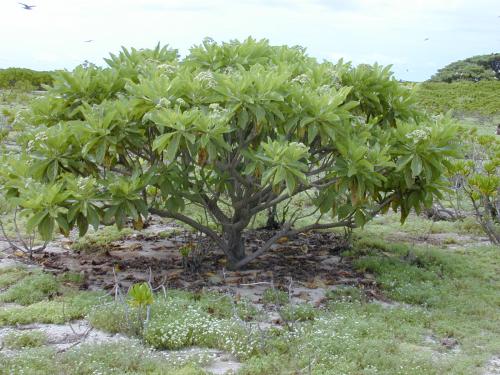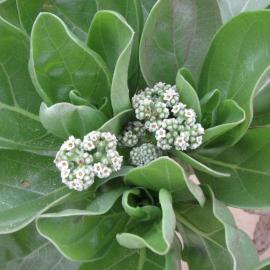In research projects in the French overseas territories in the South Pacific, Indigenous peoples and scientists are often depicted as close partners during the initial research and data collection stage.
However, Indigenous peoples usually disappear during the development stage of an innovation, and they are seldom associated with the patent registration and claims.
A recent case highlights this situation. In the 1990s, French researchers from the Institut de Recherche pour le Développement (IRD) began a project in New Caledonia and Vanuatu focused on identifying traditional medicines used by Indigenous and local communities for the treatment of ciguatera, a type of food poisoning resulting from the ingestion of contaminated fish by ciguatoxins.
The Development of a Biotechnological Innovation
The first goal of the IRD researchers was to evaluate and confirm the biological resources used by communities. Field surveys of Indigenous and local populations led to the identification of nearly a hundred plants used in traditional medicine, including the most common remedy, the decoction of leaves of Heliotropium foertherianum (or “faux tabac”). The results of this first phase were published in a number of articles and in a book.
The second objective of the researchers was to try to increase the efficiency of the biological resources in order to produce a drug or a treatment that met the requirements of health authorities and that could be widely marketed. Following laboratory analysis of this plant, the researchers were able to identify an active principle useful against ciguatera. Having isolated and identified it as rosmarinic acid, IRD first filed a patent on the use of this molecule in France with the National Intellectual Property Institute (INPI), before making an application to the European Union level with the European Patent Office (EPO) in 2010.

To be protected by a patent, an innovation must meet three criteria: novelty, non-obviousness (or inventiveness), and usefulness. The first two criteria are the most important ones. The novelty requirement means that an invention is not patentable if it was known to the public before the date of filing of the patent application. The non-obviousness criterion means that an invention should be sufficiently inventive in order to be patented. The assessment of the IRD patent was based on these two criteria.
In 2009, INPI assessed IRD’s patent application and pointed to a lack of novelty. One of the documents stated that “the most popular plant is Argusia Argentea and an aqueous extract of the leaves showed activity against ciguatoxin poisoning” (underline added). It was further stated that the molecule claimed “was prepared according to the usual method;” that is to say, the method used by local people to carry out the traditional remedy. Therefore, because of these citations, INPI concluded that there was a lack of novelty.
In response to this opinion, the IRD amended their claims in 2010 by adding that the compound identified and claimed in their application is used “isolated.” The way the claim was initially articulated meant that the IRD intended to obtain a patent on any product containing molecules of rosmarinic acid. With the rephrasing they could only claim protection for isolated molecules of rosmarinic acid. Furthermore, while acknowledging the existence of different traditional medicines and in particular a remedy based on Argusia of Argentera, the applicants specified that “there is no scientific evidence of the effectiveness of this type of treatment or its safety.” IRD added that, in their opinion, “none of the documents discloses or suggests what (s) could (are) be or chemicals responsible for the effect of extracts of H. foertherianum on the treatment of ciguatera.” Furthermore, IRD stated that “it was not known at the date of filing of this patent application that such a plant extract may contain a compound of general formula as rosmarinic acid.”
IRD felt that traditional knowledge should not be an obstacle to determining the novelty of an invention when a specific compound is identified and isolated. In practice, the researchers were focused on analyzing the effectiveness of traditional medicines and identifying the active compound. As a result, local communities would be denied any right on the invention (for instance to be included among inventors or as co-holders of the patent) due to their inability to scientifically demonstrate the effectiveness of their treatments or describe the chemical active compound of a plant extract by Western and scientific criteria.
Following the amendment of its claims with INPI, IRD continued its efforts with the European Patent Office (EPO) in 2010, in order to obtain an international protection of its patent. At this point the EU procedure takes over the French procedure and the EPO will decide on the IRD claim. The French patent claim is used to obtain a date of priority on the invention.
Based on the documents provided by the IRD, and those provided by a third party, the EPO determined that the application relating to rosmarinic acid did not meet the conditions for the grant of a patent.
In this case, the EPO held that “the skilled person [given the disclosures produced] try, without being inventive, aqueous extracts to isolate the most active compound against ciguatera. It is known [produced disclosures] that this compound is in the aqueous extract of the leaves of Argusia argentea. The only thing to do to find the active principle is to separate the individual compounds and examine their activity.” In other words, the researchers did not demonstrate their inventiveness. In addition, the researchers relied on the most popular local remedy, making it more likely that they would discover a relevant active compound. As a result of this, EPO issued a negative opinion on the IRD claim. The research institute may still try to prove that the researchers have met the criteria to claim a patent. However, for almost a year now the review of the claim has not moved forward.
Conclusion
Could you imagine a situation in which an Indigenous representative was allowed to enter the IRD, visit the laboratories, gather as much information as she pleased, and finally, return to her community to exploit the information as she wished? The reality is that before the Indigenous representative even entered the IRD, she would be required to sign a confidentiality agreement. And if she was to be involved in research, a clear agreement on the ownership of the research results would also be signed up front.
The fact that such practices do not apply to researchers (from any field) participating in projects involving Indigenous people and their heritage and resources is problematic. There is very clearly a prejudice against Indigenous communities.
This example illustrates the growing need for ethical and legal frameworks to regulate relations between local communities and researchers related to access to Indigenous intangible cultural heritage and the development of biotechnology innovations.
It is important to emphasize the shared responsibility of the State, researchers, and Indigenous communities in adopting such frameworks. Indeed, if France and local authorities (such as the government of New Caledonia) have failed to implement international treaties, researchers and communities should not wait for changes to international principles, but rather should attempt to take action to overcome the lack of state regulation.
In The Need for Fairness in the Relationship Between Researchers and Indigenous Peoples, published in 2007, the Centre National de la Recherche Scientifique (CNRS) Ethics Committee recognized that
“as indigenous people who contribute to research are denied strong rights at the international level, equity mainly depends on the willingness of the research teams and their management to organize and adapt their practices to the requirements in play.”
Until now, this statement has not led to the adoption of new ethical frameworks related to projects involving Indigenous people. However, a code of ethics, related to informed consent, sharing of research benefits and IP, was drafted in 2014 in the CNRS laboratory (the Criobe – Centre de Recherche Insulaires et Observatoire de l’Environnement) on the island of Moorea in French Polynesia. The code aims to inform and frame this research project, which involves Indigenous and local people and their heritage. If this new project is approved, it may set a precedent for the way research is conducted in French Polynesia, involving Tahitian people and their tangible and intangible heritage.
Photos: "Faux Tabac" flower (Wikimedia Commons) and "Faux Tabac Tree" (Forest and Kim Starr, Wikimedia Commons).
Recommended Reading
Bannister, Kelly and Katherine Barrett. 2000. Challenging the Status Quo in Ethnobotany: A New Paradigm for Publication May Protect Cultural Knowledge and Traditional Resource. Cultural Survival Quarterly, 24 (4):10-13.
Bannister, Kelly. 2005. Use of Traditional Knowledge for University Research: Conflicts between Academic Ethics and Research Policies, in Biodiversity and Health: Focusing Research to Policy. Edited by John Thor Arnason, P. M. Catling, E. Small, P. T. Dang, and J. D. Lambert. Ottawa: NCR Press, 122-129.
Bannister, Kelly. 2008. Non-Legal Instruments for the Protection of Intangible Cultural Heritage: Key Roles for Ethical Codes and Community Protocols, in Protection of First Nations Cultural Heritage: Laws, Policy, and Reform. Edited by Catherine Bell and Robert K Paterson. Vancouver: UBC Press, 278-308.
Burelli, Thomas. 2013. « Collaboration entre scientifiques et communautés autochtones et locales : Le patrimoine culturel immatériel autochtone face aux logiques de développement et de valorisation de l’innovation » dans Hélène, Gaumont-Prat. Innovation et Droit : Actualités de la jurisprudence en matière de propriété industrielle, coll. « Grands Colloques », L.G.D.J, p. 135-154.
Our Appropriation (?) of the Month features, written by IPinCH team members, highlight the complexity of 'cultural appropriation' and 'cultural appreciation'.
Thomas Burelli is a PhD Candidate in Law at the University of Ottawa, and an IPinCH Associate.






